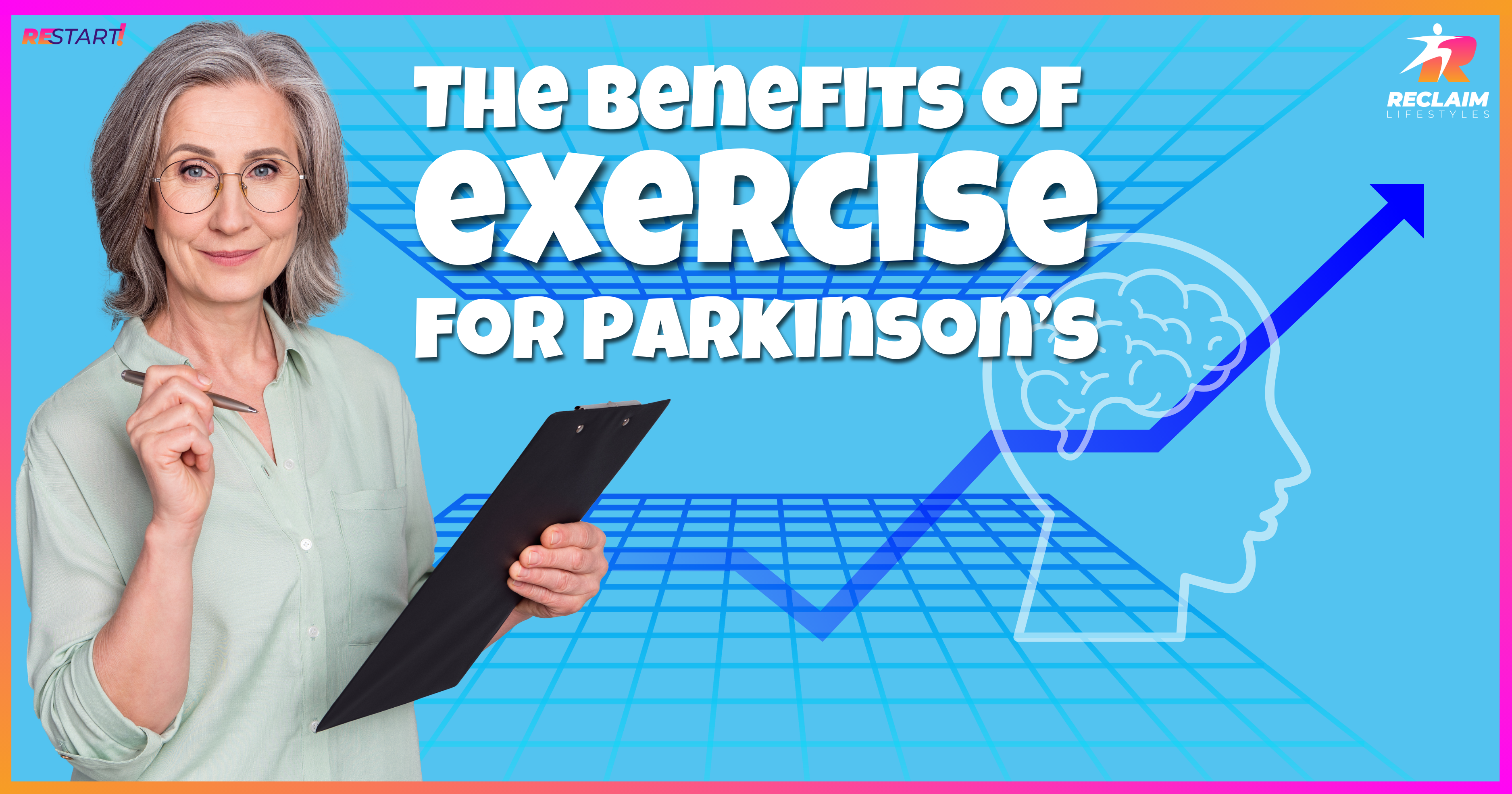Diagnosed with Parkinson’s? How Getting Active Can Help
A lot has changed in the treatment of Parkinson’s disease since doctors once prescribed rest at the onset of physical symptoms. In fact, earlier diagnoses and more recently established research support the positive effects of prescribing the opposite of rest. And now, more and more Parkinson’s patients are finding relief from their symptoms, or even delaying the development of those symptoms in the first place. We spoke with friend-of-the-Reclaim-team and physical therapist Beth Schmelling, PT, about how Parkinson’s symptoms can be alleviated with physical activity as well as some specialized therapies.
Symptoms That Can Slow You Down
Parkinson’s patients can experience a spectrum of symptoms, such as bradykinesia, which is slowed movement, resting tremors, rigidity, “freezing” while trying to initiate motion, and voice and speech difficulties. Parkinson’s effects on reducing balance were once why doctors told patients not to engage in physical activity or to only do so with one-on-one supervision and guidance due to the increased risk of falls. However, now the medical community fully recognizes the proven benefits of getting and staying active, and Parkinson’s patients are encouraged to workout as much and as safely as they can.
Thanks to earlier diagnoses, many folks learn they have Parkinson’s while they are still able to do most general exercise. As long as you feel safe, you should absolutely maintain an active lifestyle. As the saying goes, use it or lose it: when it comes to the body’s systems that are most affected by Parkinson’s, making use of them can slow the progression of the disease and alleviate symptoms.
For Parkinson’s patients who may be in a later stage of the disease, you’ll want to take your individual circumstances into consideration, such as planning your workouts for when your medications are at their peak, or adapting exercises as needed, like holding onto a chair for balance exercises, skipping anything that doesn’t feel safe, or enlisting a workout buddy to be there in case you need a hand.
Workout Recommendations for Parkinson’s Disease
There’s a lot that can be done if your symptoms have yet to develop or are well-managed, and exercise is associated with slower disease progression and improved quality of life. The American College of Sports Medicine (ACSM) teamed up with the Parkinson’s Foundation to develop recommendations for Parkinson’s patients’ physical activity. They suggest:
- 30 minutes of aerobic activity 3 days/week
- Brisk walking
- Running
- Cycling
- Swimming
- Aerobics class
- 30 minutes of strength training 2-3 non-consecutive days/week
- Weight machines
- Resistance bands
- Light/moderate handheld weights
- Body weight exercises
- Balance, agility, and multitasking activity 2-3 days/week with daily integration if possible
- Multi-directional stepping
- Weight shifting
- Dynamic balance activities
- Large movements
- Yoga
- Tai Chi
- Dance
- Boxing
- Stretching at least 2-3 days/week but up to daily
- Sustained stretching with deep breathing
- Dynamic stretching before exercise
Download the official handout from Parkinson.org here to see all the considerations and additional tips.
One specific workout/movement tip that helps a lot of folks with Parkinson’s who experience difficulties initiating movement is to focus on a different kind of task for a moment, and then return to the movement you’re trying to do. For example, you want to take a step forward, but you’re stuck. Turn your attention to a cognitive task, like recalling a phone number and saying it out loud, solving a math problem, or having someone else quiz you with a question like, “When’s your anniversary?” (Hopefully if that other person is your spouse, you won’t have to think too long to answer!) Shifting from the physical task to a cognitive task and back again can “unlock” you and allow you to take that step forward.
Getting Help from the Pros
When a patient is diagnosed with Parkinson’s, their physician will commonly refer them to a physical therapist, especially if the patient is already exhibiting physical symptoms of the disease. Like we’ve discussed in previous posts about physical therapy, it can be a good idea to take the time to find a therapist who offers modalities relevant to your condition, and in this case, specializes in Parkinson’s and/or neurological conditions. Not every therapist has experience with neurological conditions like Parkinson’s, so it’s also important to determine whether they are someone who is willing to learn what’s needed if it’s new territory for them.
At your first visits, your PT will assess your baseline: your range of motion, whether it’s limited by your joints or muscle tightness, your ability to perform functional movements for everyday activities, your balance, muscle tone, and strength. From there, the therapist will want to get an understanding of what your goals are. What activities are really important to you to be able to keep doing for as long as possible? What’s getting in your way the most? With the assessment results and goals you’ve identified, your therapist will develop a plan to help you maintain and improve your functionality and abilities.
Beyond physical therapy, Parkinson’s patients can also choose to work with personal trainers on a workout plan specifically tailored to their needs and goals. ACSM and Parkinson’s Foundation have developed guidelines for exercise professionals in addition to guidelines for patients to help trainers and other exercise pros create appropriate workout plans for clients with Parkinson’s. Trainers (like our bud Ben Dreyer) can also get certified in Parkinson’s-specific training programs like PWR!Moves, and in fact, Ben is doing that very certification! Rock Steady Boxing is another curriculum built for Parkinson’s patients using non-contact, boxing-based fitness.
In the realm of professional therapy, Lee Silverman Voice Technique (LSVT) is an additional option for Parkinson’s patients who experience vocal symptoms like a soft voice or other speaking difficulties. LSVT began with voice therapy, but has since added a movement therapy component that helps with movement control, as patients can have difficulties initiating and stopping movements, and/or movements can become tighter and smaller. While LSVT has been around since the late 1980s, it has increased in popularity thanks to the now-25 years of research backing it up.
What the Research Says
Speaking of research, how do we know that physical activity is so good for people with Parkinson’s disease? Lots of studies have been done over the last several decades examining the effectiveness of various interventions in treatment of Parkinson’s, so it can be more helpful to look at studies of those studies, called meta-analyses, which give a high-level overview of a group of studies. This meta-analysis1 published in the scientific journal Neurorehabilitation and Neural Repair looked at 191 studies of various treatment modalities, from physiotherapy to dance, martial arts, hydrotherapy, exergaming, and more. The meta-analysis found that participants experienced significant improvements in motor symptoms, gait, and quality of life by participating in almost all of the studied modalities. The only modality that didn’t significantly improve any of the studied outcomes was dual task training. Here’s a summary of which outcomes were improved by the modalities covered in the meta-analysis:
|
Modality |
Outcomes Improved |
|
Conventional Physiotherapy |
Motor Symptoms, Gait, Quality of Life |
|
Resistance Training |
Gait |
|
Treadmill Training |
Gait |
|
Strategy Training |
Balance and Gait |
|
Dance |
Motor Symptoms, Balance, Gait |
|
Nordic Walking |
Motor Symptoms, Balance, Gait |
|
Balance and Gait Training |
Motor Symptoms, Balance, Gait |
|
Martial Arts |
Motor Symptoms, Balance, Gait |
|
Exergaming |
Balance and Quality of Life |
|
Hydrotherapy |
Balance |
Radder DLM, Lígia Silva de Lima A, Domingos J, et al. Physiotherapy in Parkinson’s Disease: A Meta-Analysis of Present Treatment Modalities. Neurorehabilitation and Neural Repair. 2020;34(10):871-880. doi:10.1177/1545968320952799
Can Parkinson’s Patients Use the Restart! App?
The Restart! exercise app was built to be accessible to anyone, no matter what their current level of fitness may be, so as long as you feel safe to do each exercise in your personalized workouts in the app, Parkinson’s patients who are in the early stages of the disease could absolutely make use of Restart! (with the caveat that you should of course always discuss any changes to your fitness routines with your doctor/care team and take any necessary precautions to ensure your safety). The exercises in the Restart! exercise library are all selected to support strength, balance, and flexibility, areas that Parkinson’s patients are proven to benefit from training in.
The app’s constant feedback collection allows users to indicate when an exercise is not working for them for whatever reason, perhaps pain, a physical limitation, or just a personal preference. Then the app adjusts the next workout accordingly, offering a different exercise that addresses the same or a similar or supporting function in a different way. The continuous feedback and adjustment loop mimics the one-on-one support you might receive from private personal training sessions, but at a fraction of the cost, on your own schedule, in your own home, and with no extra equipment necessary.
It might seem like with a condition like Parkinson’s disease, you would need to only engage with specific exercise programs for Parkinson’s, and while that is certainly an option with organizations like PWR!Moves and Rock Steady, the research shows that there are a lot of options for Parkinson’s patients to improve their condition through physical activity. It doesn’t really have to be all that complicated; the most important thing (other than being safe!) is to get moving, however you can. Finding something that is easy to do and that you enjoy doing will go a long way toward helping you establish a consistent habit to maintain and improve your functionality while living with Parkinson’s. And if that something just so happens to be the Restart! app, we’re glad to have you on board.
Try Restart! free for your first quarter (three months) when you download the app and enable the free trial period. Then subscribe for just $24.99/quarter to keep up your new workout habit. Available now in the App Store and Google Play:


